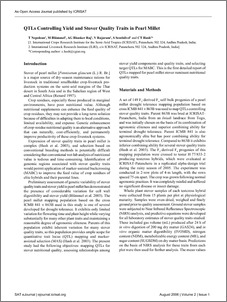QTLs Controlling Yield and Stover Quality Traits in Pearl Millet
Abstract
Stover of pearl millet (Pennisetum glaucum (L.) R. Br.) is a major source of dry-season maintenance rations for livestock in traditional smallholder crop-livestock production systems on the semi-arid margins of the Thar desert in South Asia and in the Sahelian region of West and Central Africa (Renard 1997). Crop residues, especially those produced in marginal environments, have poor nutritional value. Although nutritional supplements can enhance the feed quality of crop residues, they may not provide a long-term solution because of difficulties in adapting them to local conditions, limited availability, and expense. Genetic enhancement of crop-residue nutritional quality is an alternative approach that can naturally, cost-efficiently, and permanently improve productivity of these crop-livestock systems. Expression of stover quality traits in pearl millet is complex (Hash et al. 2003), and selection based on conventional breeding methods is potentially difficult considering that conventional wet-lab analysis of nutritional value is tedious and time-consuming. Identification of genomic regions associated with stover quality traits would permit application of marker-assisted backcrossing (MABC) to improve the feed value of crop residues of elite hybrids and their parental lines. Preliminary assessment of genetic variability of stover quality traits and stover yield in pearl millet has demonstrated the presence of considerable variation for cell wall digestibility and stover yield (Blümmel et al. 2003). The pearl millet mapping population based on the cross ICMB 841 × 863B used in this study is one of several developed for drought tolerance. It exhibits only limited variation for flowering time and plant height while varying substantially for many other plant traits and maintaining a reasonable degree of agronomic eliteness. Parents of this population exhibit inherent variation for many stover quality traits, so this population provides ample scope for quantitative trait locus (QTL) mapping and markerassisted selection (MAS) (Hash et al. 2003). The present study had the following objectives: mapping QTLs for stover nutritional quality, assessing relationships amongstover yield components and quality traits, and selecting target QTLs for MABC. This is the first detailed report of QTLs mapped for pearl millet stover ruminant nutritional quality traits

